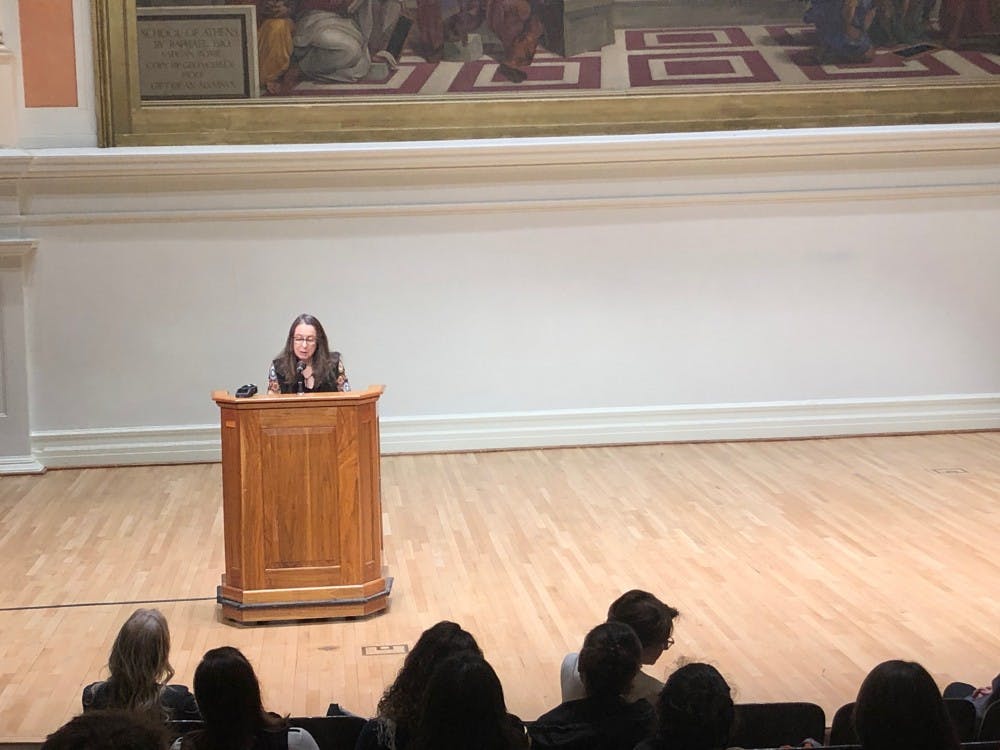Writer Ann Beattie has been churning out novels and short stories since the seventies and possesses a fame large enough to have an adjective inspired by her work — Beattie-esque. Her work helped define the generation of smart, blunt commentary contributors to the late 20th century, with pieces that considered themes of humanity through plots revolving around how people act in deep winter.
It’s no surprise that Beattie decided to teach master classes for MFA students and creative writing undergraduates. During her time as a professor at the University, a span of twelve years from 2000 to 2012, Beattie was a fundamental cornerstone of the English and Creative Writing department, serving as the Edgar Allan Poe Chair of the English Department. She resigned with a narrative of disagreement for the direction of the University, making her current return and residency a surprise. As part of her stay as the Kapnick Distinguished Writer in Residence, Beattie read from her short fiction in Old Cabell Hall Oct. 17 , gave a lecture on the craft of fiction last Thursday and will give another on Nov. 14.
Beattie’s Old Cabell reading was a generous glance into the capabilities of her brilliant mind as a writer. Her assertive disposition as a professor was on display in the masterclass she had taught earlier in the day. When Professor of Poetry Lisa Russ Spaar introduced her briefly at the podium, she said, “I think those of us in attendance today are still high about it” — and a buzzing murmur from the crowd affirmed Spaar’s speculation. At the craft lecture on Oct. 24, Spaar relished in the moment to compliment Beattie’s impact to the university during her stay, voicing her gratitude at Beattie’s enrichment of the University community.
Whereas students and faculty alike benefited from Beattie’s close analysis of a story by Mavis Gallant, with her conducting glances at Gallant’s “writerly moves,” her reading in Old Cabell affirmed her distinguished status as a renowned writer. She read from two stories. The first one, an older story that first appeared in The New Yorker in 1984 called “In the White Night,” dials in on the all consuming fragility of domesticity in a landscape of discomforting winterness.
Her reading delivered the “Beattie-esque” value described by Beattie’s introducer, Susie Eckel, MFA student in prose. Her minimal evaluation of her character’s circumstances was present starting with the first few sentences, as she described the characters as being at a dinner party where their comparative and human natures were on full display. Beatties characterization tactic gives a wonderful articulation of what it meant to be involved in suburban family life in the 1980s — and included a revelation of how heartbreaking that idealized life could end up. Beattie’s “In the White Night” has a functional and honest realism that reflects an intimate relationship with the time and the stirring problems in the conditions of the time.
Beattie’s second story was a more disappointing entry into her canon as a writer. “April Paintings” — set in a buildup on I-64 South in present day — possessed far too many stumbling assumptions of her character’s behaviors that just weren’t real enough to be overlooked. The two girls in the story, Karen and April, are positioned in an implicating, probably queer relationship — yet by just leaning towards a queer nature, Beattie falls into the queer-baiting trap many straight writers encounter by lacking the specificity so generously awarded to depicitons of straight love.
“April Paintings” gives away Beattie’s out of touch position in another scene that accounts one girl’s thoughts as first acknowledging the lack of radio signal before considering perhaps playing music from her phone. The undergraduate listeners in the crowd also looked at each other in vague disbelief when the story told of the diversity in bumper stickers of the backed-up traffic by listing off prominent possibilities of today. It seemed trope-ish and over the top to so forcibly insert the state of politics today through bumper stickers. Beattie tried to write a smart story about the social boundaries of today interlaced with an ode to Virginia, but sidetracked to a territory that was lost upon those listeners close to the age of her characters.
Despite the relative aversion to Beattie’s second story shared at the reading, her legacy at the University garnered her the prestige of holding the event in Old Cabell Hall. There seemed to be a bit of injustice of Beattie’s access to the much grander Old Cabell Hall versus the Bookstore Mezzanine — where novelist Álvaro Enrigue read to his audience on Sept. 19, against the backdrop of students shopping for textbooks. It’s undeniable that Beattie’s efforts at the University and as a writer speak for themselves but the venue was still a surprise. Former Kapnick writers Ross Gay and Mark Doty both read in the Special Collections Library, rather than the more acoustic and dramatic space offerred by Old Cabell.
Lisa Russ Spaar expressed luck and gratitude for having the space at the reading, and perhaps that is all it merits. After all, Ann Beattie has constantly created works that deserve such a high-ceilinged and extravagant room. And it’s true that Beattie does inspire people and does incite wonder in them. And as Eckel mentioned in her introduction, one YouTube comment on a Seth Meyers interview Beattie did this past summer seems to sum up the author and her work.
“Ann is one intellectual babe.”
Ann Beattie will continue her stay as the Kapnick Distinguished Writer-in-Residence through the Fall semester. Her final lecture will take place Nov. 14 in Minor Hall 125.







